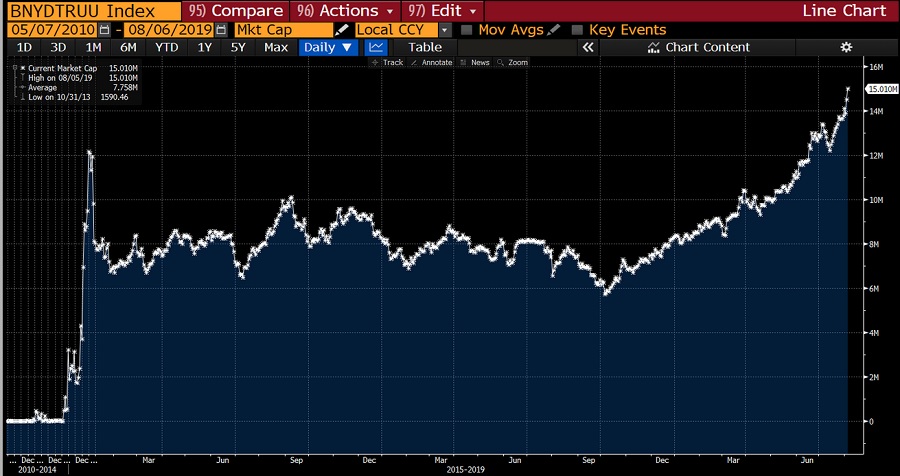A Race to Hell: Negatively Yielding Debt Tops $15 Trillion for First Time Ever
Negative yielding debt has exceeded $15 trillion globally for the first time ever.
This pile of negatively yielding paper includes government and corporate bonds, along with some euro junk bonds.
WolfStreet called it a “race to hell.”

As the Financial Times put it last month, negative bond yields were once considered to be “economic lunacy.” Now they are economic normalcy.
The Federal Reserve could have at least slowed the race down this road to hell with ist normalization project, but that didn’t go very far. The amount of negative-yielding bonds has grown precipitously since the Fed did a monetary policy 180 with the Powell Pause earlier this year. The European Central Bank poured fuel on the fire when it hinted at new rate cuts and even another round of quantitative easing.
The Fed has now taken another step in the opposite direction with its first interest rate cut in over a decade last week. Peter Schiff says this is the first cut on the short road to zero. That will likely mean even more negative-yielding debt. And as WolfStreet put it, the NIRP zone is already growing like an octopus.
In Germany, there are no longer any bonds trading with a positive yield. According to WolfStreet, “The German 30-year yield, for bonds due in 2048, the longest term available, dipped into the negative briefly on Friday for the first time and sank solidly into the negative on Monday and Tuesday, currently at negative -0.036%.”
The Swiss 30-year bond has been negative since mid-2016. It is currently at -0.322%.
Meanwhile, there are now 12 countries with 10-year bonds with negative yields.
| 1 | Switzerland | -0.92% | |
| 2 | Germany | -0.53% | |
| 3 | Denmark | -0.49% | |
| 4 | Netherlands | -0.43% | |
| 5 | Austria | -0.30% | |
| 6 | France | -0.27% | |
| 7 | Finland | -0.27% | |
| 8 | Sweden | -0.21% | |
| 9 | Belgium | -0.20% | |
| 10 | Japan | -0.18% | |
| 11 | Slovakia | -0.14% | |
| 12 | Slovenia | -0.04% |
There are some countries where you can get some solid positive yields. For instance, 10-year yield on Zambia’s euro-denominated bonds is now over 31%. Of course, that country’s credit rating is just a tick above default. Government debt in Zambia has ballooned from about $2 billion in 2011 to over $10 billion last year. There are also allegations that the government is even deeper in debt and is hiding the fact. So, maybe not your best bet.
You could try Turkey. The 10-year yield there is 15%. Of course, the country remains mired in a currency crisis.
Or you could check out some central American countries like Argentina and Mexico. They have solid bond yields, but watch out for inflation.
We’re also seeing a precipitous rise in negatively yielding corporate debt, according to Bloomberg, as of last month it comprised nearly a quarter of the investment-grade market.
And as companies take advantage of low interest rates to borrow more, issuance has helped drive junk bonds outstanding to more than $1.23 trillion, more than double the level a decade ago.”
Here’s the $64,000 question: why are people pouring money into negative yielding bonds? At some point they are going to figure out losing money over time isn’t a great investing strategy. Perhaps at that point, they will turn to gold and silver.
In fact, there is a strong correlation between the rising level of negatively-yielding debt and the price of gold, according to the World Gold Council.
As global yields continue to fall, and in some cases turn negative, there appears to be a direct correlation between global net negative yielding debt and the price increase in gold, highlighting that as yields decrease, the opportunity cost of holding gold decreases making it more attractive.”
There is no end in sight to the central bank policies driving this pile-up of negative-yielding debt. And while the Fed has said it is not moving toward a sustained rate-cutting cycle, more cuts are almost certainly on the horizon. That means we can expect even more negative yields in the future.





 Since Nayib Bukele became president of El Salvador, El Salvador has been in American media and global political discussion more than ever. While much of the attention focuses on Bukele’s mass incarceration of gang members and a decline in homicide of over 70%, Bukele has also drawn attention to his favoritism towards Bitcoin and how he […]
Since Nayib Bukele became president of El Salvador, El Salvador has been in American media and global political discussion more than ever. While much of the attention focuses on Bukele’s mass incarceration of gang members and a decline in homicide of over 70%, Bukele has also drawn attention to his favoritism towards Bitcoin and how he […] With gold hitting yet another awe-inspiring all-time high in the wake of Powell’s remarks reassuring markets (more or less) to expect rate cuts in 2024, a few analysts are pointing out risk factors for a correction — so is there really still room to run?
With gold hitting yet another awe-inspiring all-time high in the wake of Powell’s remarks reassuring markets (more or less) to expect rate cuts in 2024, a few analysts are pointing out risk factors for a correction — so is there really still room to run? Gold hit a new all-time nominal high, surpassing the previous record set in December of the previous year. The precious metal’s price reached approximately $2,140, indicating a robust and continuing interest in gold as a safe-haven asset, despite a rather peculiar lack of fanfare from the media and retail investors. This latest peak in gold […]
Gold hit a new all-time nominal high, surpassing the previous record set in December of the previous year. The precious metal’s price reached approximately $2,140, indicating a robust and continuing interest in gold as a safe-haven asset, despite a rather peculiar lack of fanfare from the media and retail investors. This latest peak in gold […] The gold price has been surging, with unprecedented central bank demand gobbling up supply. It has been a force to behold — especially as US monetary policy has been relatively tight since 2022, and 10-year Treasury yields have rocketed up, which generally puts firm downward pressure on gold against USD.
The gold price has been surging, with unprecedented central bank demand gobbling up supply. It has been a force to behold — especially as US monetary policy has been relatively tight since 2022, and 10-year Treasury yields have rocketed up, which generally puts firm downward pressure on gold against USD.  Total gold demand hit an all-time high in 2023, according to a recent report released by the World Gold Council. Last week, the World Gold Council (WGC) released its Gold Demand Trends report, which tracks developments in the demand for and use of gold around the world. Excluding over-the-counter (OTC) trade, 2023 gold demand fell slightly from 2022 […]
Total gold demand hit an all-time high in 2023, according to a recent report released by the World Gold Council. Last week, the World Gold Council (WGC) released its Gold Demand Trends report, which tracks developments in the demand for and use of gold around the world. Excluding over-the-counter (OTC) trade, 2023 gold demand fell slightly from 2022 […]